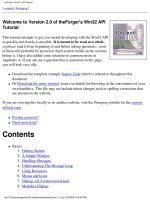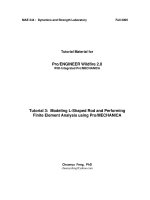UML 2 0 tutorial english ebook
Bạn đang xem bản rút gọn của tài liệu. Xem và tải ngay bản đầy đủ của tài liệu tại đây (7.15 MB, 244 trang )
(c) 2005-2006, Dr. H. Störrle, Dr. A. Knapp
UML 2.0 – Tutorial (v4) 1
Unified Modeling Language 2.0
Part 1 - Introduction
Prof. Dr. Harald Störrle
University of Innsbruck
mgm technology partners
Dr. Alexander Knapp
University of Munich
(c) 2005-2006, Dr. H. Störrle, Dr. A. Knapp
UML 2.0 – Tutorial (v4) 2
1 - Introduction
History and Predecessors
• The UML is the “lingua franca” of
software engineering.
• It subsumes, integrates and
consolidates most predecessors.
• Through the network effect, UML has a
much broader spread and much better
support (tools, books, trainings etc.)
than other notations.
• The transition from UML 1.x to UML
2.0 has
– resolved a great number of issues;
– introduced many new concepts and
notations (often feebly defined);
– overhauled and improved the
internal structure completely.
• While UML 2.0 still has many problems,
it is much better than what we ever had
before.
current version (“the standard”)
formal/05-07-04 of August ‘05
(c) 2005-2006, Dr. H. Störrle, Dr. A. Knapp
UML 2.0 – Tutorial (v4) 3
1 - Introduction
Usage Scenarios
• UML has not been designed for specific, limited usages.
• There is currently no consensus on the role of the UML:
– Some see UML only as tool for sketching class diagrams
representing Java programs.
– Some believe that UML is “
the prototype of the next generation of
programming languages”
.
• UML is a really a system of languages (“notations”, “diagram types”)
each of which may be used in a number of different situations.
• UML is applicable for a multitude of purposes, during all phases of
the software lifecycle, and for all sizes of systems - to varying
degrees.
(c) 2005-2006, Dr. H. Störrle, Dr. A. Knapp
UML 2.0 – Tutorial (v4) 4
1 - Introduction
Usage Scenarios
(c) 2005-2006, Dr. H. Störrle, Dr. A. Knapp
UML 2.0 – Tutorial (v4) 5
1 - Introduction
Diagram types in UML 2
UML is a coherent system of languages rather than a single language.
Each language has its particular focus.
(c) 2005-2006, Dr. H. Störrle, Dr. A. Knapp
UML 2.0 – Tutorial (v4) 6
1 - Introduction
Diagram types also depend on their usage
• Each diagram type may be used in
a multitude of settings, for each of
which different rules and best
practices may apply.
• For instance, class diagrams may
be used during analysis as well as
during implementation.
• During analysis, this class diagram
is bad, or at least suspicious.
• During implementation, it is bad if
and only if it does not correspond
to the code (or other structure) it
is used to represent.
(c) 2005-2006, Dr. H. Störrle, Dr. A. Knapp
UML 2.0 – Tutorial (v4) 7
1 - Introduction
Internal Structure: Overview
• The UML is structured using a metamodeling approach with four layers.
• The M
2
-layer is called metamodel.
• The metamodel is again structured into rings
, one of which is called
superstructure, this is the place where concepts are defined (“the
metamodel” proper).
• The Superstructure is structured into a tree of packages
in turn.
(c) 2005-2006, Dr. H. Störrle, Dr. A. Knapp
UML 2.0 – Tutorial (v4) 8
1 - Introduction
Internal Structure: Layers
(c) 2005-2006, Dr. H. Störrle, Dr. A. Knapp
UML 2.0 – Tutorial (v4) 9
1 - Introduction
Internal Structure: Layers
(c) 2005-2006, Dr. H. Störrle, Dr. A. Knapp
UML 2.0 – Tutorial (v4) 10
1 – Introduction
Internal Structure: Rings
(c) 2005-2006, Dr. H. Störrle, Dr. A. Knapp
UML 2.0 – Tutorial (v4) 11
1 - Introduction
Internal Structure: Packages
(c) 2005-2006, Dr. H. Störrle, Dr. A. Knapp
UML 2.0 – Tutorial (v4) 12
1 - Introduction
Diagrams and models
diagram name
(pragmatic)
diagram kind
model
(abstract syntax)
diagram
(concrete syntax)
represent present
datastructure,
instance of the metamodel
(c) 2005-2006, Dr. H. Störrle, Dr. A. Knapp
UML 2.0 – Tutorial (v4) 13
1 - Introduction
UML is not (only) object oriented
• A popular misconception about UML is that it is “object oriented” by
heart – whatever that means.
• It is true that
– UML defines concepts like class and generalization;
– UML is defined using (mainly) a set of class models;
– UML 2.0 rediscovers the idea of behavior embodied in objects.
• However, UML 2.0
– also encompasses many other concepts of non- or pre-OO origin
(Activities, StateMachines, Interactions, CompositeStructure, …);
– may be used in development projects completely independent of
their implementation languages (Java, Cobol, Assembler, …);
– is not tied to any language or language paradigm, neither by
accident nor purpose.
(c) 2005-2006, Dr. H. Störrle, Dr. A. Knapp
UML 2.0 – Tutorial (v4) 14
1 - Introduction
UML 1.x vs. UML 2.0
UML 1.x
• Collaboration diagram
• ActivityGraph is a StateMachine
UML 2.0
• Communication diagram
• Activity is a Behavior (“Petri-like”)
New features in UML 2.0
• Activities: exceptions, streams,
structured nodes, …
• traverse-to-completion
• Timing diagram
• interaction overview diagram
• composite structure diagram
• interaction operators
• collaborations
Other novelties
• Detail changes everywhere
• New overall structure
(c) 2005-2006, Dr. H. Störrle, Dr. A. Knapp
UML 2.0 – Tutorial (v4) 15
1 - Introduction
UML 1.x vs. UML 2.0
• UML 2.0 has several advantages over UML 1.x:
– many powerful new concepts
– much better definitions (i.e. semantics)
– improved internal structuring
• However, even though UML 2.0 is much better defined than UML 1.5, the
state is still not satisfying, e.g.
–syntax
• overloaded notation: too many synonyms, too much sugaring,
• lack of notational orthogonality, some people don’t even want this,
–semantics
• lack of precise semantics: informal, unclear and contradictory definitions,
– pragmatics
• lack of methodological basis such as model consistency conditions, usage types etc.
• Still, it‘s the best comprehensive (“unified”) modeling language we ever had.
(c) 2005-2006, Dr. H. Störrle, Dr. A. Knapp
UML 2.0 – Tutorial (v4) 16
1 - Introduction
Wrap up
• UML is the lingua franca of software engineering.
• It has many problems, yet it is better than anything we had before.
• It may be used during the whole software lifecycle. UML may help to
plan, analyze, design, implement, and document software.
• The UML is structured
– by a 4-layer metamodeling approach
(M
0
: system, M
1
: model, M
2
: meta model, M
3
: meta meta model),
– the metamodel is structured into 3 rings
(infrastructure, superstructure, extensions),
– the superstructure is organized as a tree of packages.
(e.g. Actions, Activities, Common Behaviors, Classes, …)
• UML is not “object oriented” by heart.
(c) 2005-2006, Dr. H. Störrle, Dr. A. Knapp
UML 2.0 – Tutorial (v4) 1
Unified Modeling Language 2.0
Part 2 – Classes and packages
Prof. Dr. Harald Störrle
University of Innsbruck
MGM technology partners
Dr. Alexander Knapp
University of Munich
(c) 2005-2006, Dr. H. Störrle, Dr. A. Knapp
UML 2.0 – Tutorial (v4) 2
2 – Classes and packages
A first glimpse
(c) 2005-2006, Dr. H. Störrle, Dr. A. Knapp
UML 2.0 – Tutorial (v4) 3
2 – Classes and packages
History and predecessors
• Structured analysis and design
– Entity-Relationship (ER) diagrams (Chen 1976)
• Semantic nets
– Conceptual structures in AI (Sowa 1984)
• Object-oriented analysis and design
– Shlaer/Mellor (1988)
– Coad/Yourdon (1990)
– Wirfs-Brock/Wilkerson/Wiener (1990)
– OMT (Rumbaugh 1991)
– Booch (1991)
– OOSE (Jacobson 1992)
(c) 2005-2006, Dr. H. Störrle, Dr. A. Knapp
UML 2.0 – Tutorial (v4) 4
2 – Classes and packages
Usage scenarios
ImplementationDesignAnalysis
√
×
Code
√√
×
Set of objects
√√Type
×
√Concept
• Classes and their relationships describe the vocabulary of a system.
– Analysis: Ontology, taxonomy, data dictionary, …
– Design: Static structure, patterns, …
– Implementation: Code containers, database tables, …
• Classes may be used with different meaning in different software
development phases.
– meaning of generalizations varies with meaning of classes
(c) 2005-2006, Dr. H. Störrle, Dr. A. Knapp
UML 2.0 – Tutorial (v4) 5
2 – Classes and packages
Analysis class diagram (1)
(c) 2005-2006, Dr. H. Störrle, Dr. A. Knapp
UML 2.0 – Tutorial (v4) 6
• Structural features (are typed elements)
– properties
• commonly known as attributes
• describe the structure or state of class instances
• may have multiplicities (e.g. 1, 0 1, 0 *, *, 2 5)
(default: 0 * = *, but 1 for association ends)
• Behavioral features (have formal parameters)
– operations
• services which may be called
• need not be backed by a method, but may be
implemented otherwise
2 – Classes and packages
Classes
• Classes describe a set of instances with common features (and
semantics).
– Classes induce types (representing a set of values).
– Classes are namespaces (containing named elements).
(c) 2005-2006, Dr. H. Störrle, Dr. A. Knapp
UML 2.0 – Tutorial (v4) 7
2 – Classes and packages
Associations
• Associations describe sets of tuples whose values refer to typed
instances.
– In particular, structural relationship between classes
– Instances of associations are called links.
• Association ends are properties.
– correspond to properties of the opposite class
(but default multiplicity is 1)
• Association ends may be navigable.
– in contrast to general properties
navigable not navigable
association end
association name
reading
direction
ternary associationqualified end (fh per date)
(c) 2005-2006, Dr. H. Störrle, Dr. A. Knapp
UML 2.0 – Tutorial (v4) 8
2 – Classes and packages
Association classes
• Association classes combine classes with associations.
– not only connect a set of classifiers but also define a set of
features that belong to the relationship itself and not to any of
the classifiers
equals association name
• each instance of Booking has one passenger and one flight
• each link of Booking is one instance of Booking
(c) 2005-2006, Dr. H. Störrle, Dr. A. Knapp
UML 2.0 – Tutorial (v4) 9
2 – Classes and packages
Data types and enumerations
• Data types are types whose instances are identified by their value.
– Instances of classes have an identity.
– may show structural and behavioral features
• Enumerations are special data types.
– instances defined by enumeration literals
•denoted by Enumeration::EnumerationLiteral or
#
EnumerationLiteral
– may show structural and behavioral features
compartments for attributes
and operations suppressed
enumeration literals









